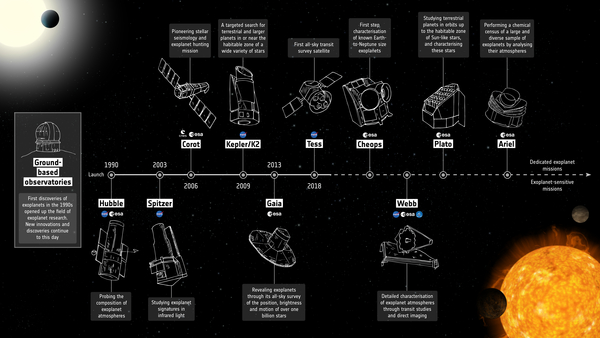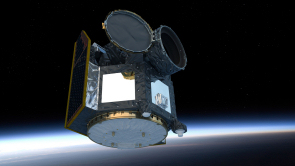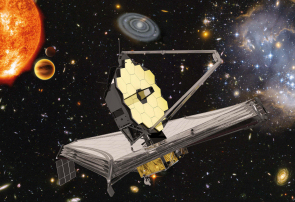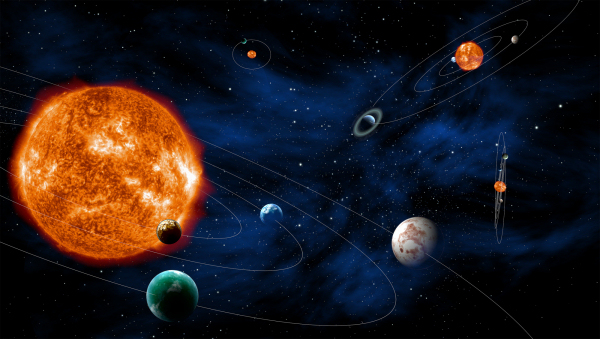The future of exoplanet research
This is a very exciting time for exoplanet research. With the steady rise in the number and type of exoplanets there is undoubtedly a lot to be learned and, as we move from an era of detecting exoplanets to one of characterising them, entire new areas of research may yet develop. For example, by analogy with our Solar System, moons should exist around exoplanets, and these might provide potential habitats for life. The search for exomoons is ongoing, but none have been detected so far.
A lot of what we know about exoplanets – including extreme examples such as the potential diamond planets and lava worlds – are still just tantalising hints that need more detailed and precise measurements before anything can be confirmed. The CoRoT and Kepler space telescopes revolutionised the field of exoplanets, and we can look forward to an exciting period ahead with the upcoming space missions. Building on what has been learned so far, the new missions are devised to detect small planets around bright stars. Because the host stars are bright the masses of the detected planets can be determined from radial velocity observations at ground-based observatories – both mass and size are essential for characterising the new discoveries.
 |
| Exoplanet mission timeline. Credit: ESA |
TESS
In 2018, NASA launched TESS (Transiting Exoplanet Survey Satellite) to perform an all-sky survey to monitor bright stars for small transiting planets. TESS stars are 30–100 times brighter than those surveyed by the Kepler satellite, which means that TESS planets should be far easier to characterise with follow-up observations. These follow-up observations will provide refined measurements of the planet masses, sizes, densities, and atmospheric properties. Planned to operate for two years, TESS will provide prime targets for further, more detailed characterisation with future large ground-based and space-based telescopes.
CHEOPS
Europe's CHaracterising ExOPlanets Satellite (CHEOPS) mission, a partnership between ESA and Switzerland, was launched in December 2019 and started operations in April 2020. Using the technique of high precision transit photometry, this mission studies known exoplanets that are smaller than Saturn and are orbiting close to bright stars.
 |
| Artist's impression of CHEOPS. Credit: ESA/ATG medialab |
A key feature of CHEOPS is its follow-up nature: it observes individual stars known to host planets, rather than carrying out sky surveys to search for more. Since scientists will know exactly when and where to point the satellite to catch the exoplanet as it transits the disc of its host star, it will be possible to observe multiple planetary transits to build up high precision on the shallow transit signatures of the smaller planets in the Earth–Neptune size range.
By combining accurate and precise measurements of an exoplanet's radius – obtained with CHEOPS – with existing mass determinations, scientists can determine accurate densities for a large sample of planets, thus making the first steps in the characterisation of these exoplanets and putting constraints on the composition of these smaller planets.
Understanding the true nature of planets requires not only measurements of mass and radius, but also a study of their atmospheric properties. By determining the physical extent of the atmospheres of super-Earths, CHEOPS will be able to discriminate between Earth-like planets where life as we know it could blossom and other kinds of Earth-mass planets (hydrogen-rich Earths, ocean planets), which challenge our current understanding of habitability. As such, CHEOPS will provide unique targets for the James Webb Space Telescope as well as for the next generation of ground-based extremely large telescopes, both of which will be capable of measuring the fingerprints of molecules in the atmospheres of nearby exoplanets.
CHEOPS will also measure the light curves for a small sample of hot-Jupiters and determine the mechanisms by which energy is transported through and around the exoplanet atmosphere. As with any science mission, CHEOPS will be used to address science questions that are more speculative, such as searching for the photometric signatures of exomoons (moons orbiting exoplanets), rings and Trojans, and will also probe questions beyond exoplanet science.
WEBB
The NASA/ESA/CSA James Webb Space Telescope, due to launch in 2021, will provide game-changing new capabilities for observations of exoplanets and their atmospheres. With a suite of four instruments operating at infrared wavelengths Webb will employ several techniques to investigate these extrasolar bodies.
Highly sensitive spectroscopic observation of transiting planets – with similar characteristics in terms of size and mass – will usher in the era of comparative planetology for exoplanets.
 |
| Artist's impression of Webb. Credit: ESA, NASA, S. Beckwith (STScI) and the HUDF Team, Northrop Grumman Aerospace Systems / STScI / ATG medialab |
Webb will characterise exoplanet atmospheres by recording absorption, reflection, and emission spectra at infrared wavelengths for planets spanning a range of sizes, from super-Earths to gas giants. It will take advantage of the fact that, at these wavelengths, molecules in the atmospheres of exoplanets exhibit a large number of spectral features, providing the observers with a rich set of diagnostic tools, many of which are not accessible from the ground.
Webb will also be able to directly image some young and massive exoplanets orbiting at larger distances from their parent star than most transiting ones. Three of Webb's instruments have high-contrast imaging capabilities (in two cases this is implemented using a coronagraph) to minimize the glare of the parent star, making it easier to image the planet. Observations with multiple infrared filters will provide a lot of information on these planets, their properties and their formation mechanisms.
PLATO
ESA's PLATO (PLAnetary Transits and Oscillations of stars) mission is scheduled to launch in 2026. PLATO is designed to detect and characterise a large number of new extrasolar planetary systems, by searching hundreds of thousands of bright stars for transiting planets. PLATO will have the unique capability to find and determine the properties of terrestrial planets that orbit in the habitable zone around stars similar to our Sun.
By combining the PLATO accurate measurements of radii for a large sample of planets with the respective planetary masses determined from ground-based observations, scientists will be able to explore the diversity of planets that exist, which in turn provides important constraints on how planets form. These observations will also allow scientists to determine the bulk composition of a large number of small planets, to study how similar they are to the Earth, and to investigate their habitability.
How the host star affects the planets that are in orbit around it is an important question that PLATO data will be used to address. Only by understanding the host star properties, such as stellar activity, type, metallicity, etc., can we understand planetary systems. For the first time, PLATO will allow scientists to calculate accurately the properties of a large number of stars with planets, including their ages. With these data, it will be possible to study the changes that planets undergo with time, and to investigate how the conditions for habitability evolve.
The large sample of systems that will be discovered by PLATO will also provide data to study the architecture and evolution of extrasolar planetary systems, by investigating the distribution of planet types – terrestrial or gaseous – with distance from the host star and with stellar age. This will allow scientists to place our Solar System in context – is its composition common or unusual?
By discovering planets orbiting bright stars, PLATO will be a pathfinder for later missions looking for signatures of life – these types of planets are the best candidates for spectroscopic follow-up measurements to measure the structure and composition of planetary atmospheres.
 |
| Searching for exoplanetary systems. Credit: ESA - C. Carreau |
ARIEL
Moving on beyond discovery towards studying and understanding, ESA's Ariel (Atmospheric Remote-sensing Infrared Exoplanet Large-survey) mission will conduct a chemical census of a large, well-defined and diverse sample of exoplanets. Conducting simultaneous observations across a range of visible and infrared wavelengths, the mission will enable a study of exoplanets both as individuals and as populations.
Due to launch in 2029, Ariel is designed to perform high-accuracy transit, eclipse, and phase-curve multiband observations employing simultaneous photometry in the visible and spectroscopy in near infrared wavelengths. It will observe and study approximately 1000 preferentially warm and hot transiting gas giants, Neptunes, and super-Earths around a range of stellar types and planetary system architectures.
Ariel will deliver an unprecedented catalogue of planetary spectra, characterising molecular abundances, chemical gradients, atmospheric structure, diurnal and seasonal variations, clouds, and albedo measurements. The mission aims to provide a truly representative picture of the chemical nature of the exoplanets studied, and also relate this directly to the type and chemical composition of their host stars, allowing scientists to investigate the nature of these planets, how they formed and how they evolve.
Outlook
With this suite of space telescopes launching within the next decade, we can expect to come closer to finding "Earth 2.0", while at the same time adding more strange and unexpected planets to the exoplanetary zoo. Exciting times lie ahead.
| Read more |
| 1: A brief introduction to exoplanets |
| 2: How to find an exoplanet - detection methods |
| 3: A zoo of exoplanets |
| 4: The future of exoplanet research |
